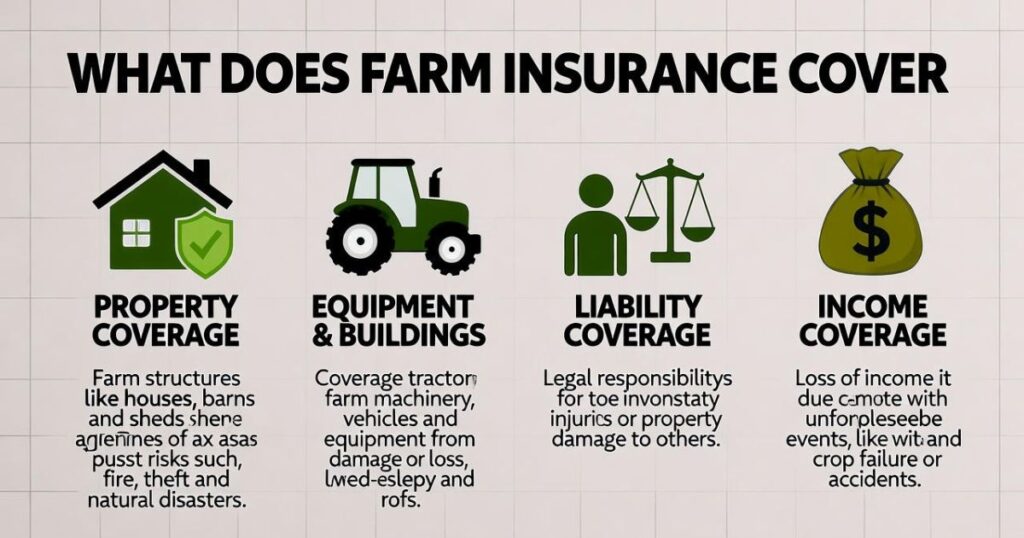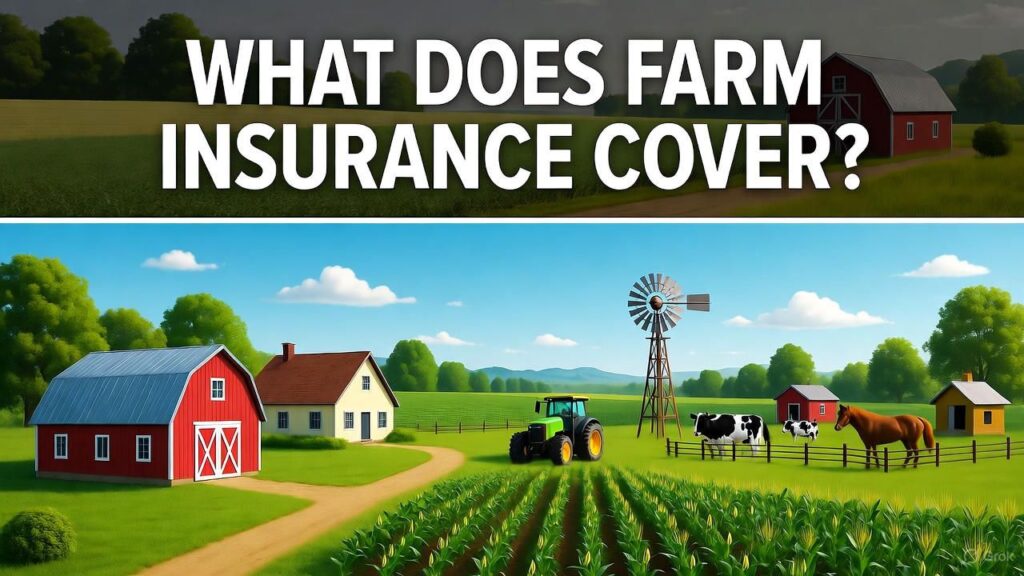Have you ever wondered what happens if a storm wrecks your barn or a visitor slips on your farm path? Farming comes with its share of surprises, and that’s where farm insurance steps in. It’s more than just a safety net; it protects your livelihood from unexpected hits.
Today, we’ll break down what farm insurance covers, so you can feel confident about safeguarding your operation. Whether you run a small family farm or a larger agribusiness, understanding farm insurance coverage is key. Let’s explore how it shields your assets without overwhelming you with details.
The Basics of Farm Insurance
Farm insurance, often called agricultural insurance, goes beyond standard homeowners policies. It tailors protection to the unique risks farmers face every day. Think about it: your home policy might cover your house, but what about tractors, livestock, or crop losses?
This type of insurance combines elements of property, liability, and sometimes even business coverage. It’s designed for those who live and work on the land. Many farmers I know sleep better at night knowing their policy has their back during tough times.
Why Farm Insurance Matters More Than Ever
Farming isn’t getting any easier with changing weather and market shifts. A good policy can mean the difference between bouncing back or facing financial ruin. For instance, a friend of mine lost equipment in a fire, and his farm insurance coverage handled the replacement costs swiftly.
Key Differences from Homeowners Insurance
Homeowners insurance falls short for farms because it doesn’t account for agricultural operations. Farm policies include outbuildings, machinery, and even farm products like hay or grain. That’s crucial if your livelihood depends on these items.

Regular home policies might exclude business activities on your property. Farm insurance fills that gap, offering comprehensive protection. It’s like upgrading from a basic toolkit to a full workshop for your needs.
Core Elements of Farm Insurance Coverage
Now, let’s dive into the heart of what farm insurance covers. Policies vary, but most include several standard protections. We’ll look at the main ones to give you a clear picture.
Property Coverage for Your Farm Assets
This is the backbone of many policies. It protects your buildings, like barns, silos, and sheds, from perils such as fire, wind, or theft. Imagine a hailstorm damaging your roof; property coverage steps in to repair it.
It also extends to personal property inside those structures. Tools, supplies, and even harvested crops might fall under this umbrella. For hobby farmers, this means peace of mind for weekend projects gone wrong.
Farm machinery gets special attention here. Tractors, combines, and irrigation systems are often covered against breakdowns or accidents. It’s handy for those unexpected field mishaps.
Outbuildings and Structures
Don’t overlook detached garages or storage units. These are typically included in farm property insurance. A collapsed fence from heavy snow? Your policy might handle the fix.
Building Materials and Supplies
If you’re in the middle of a renovation, coverage can protect unfinished materials. It’s a small detail that saves big headaches.
Liability Protection on the Farm
Accidents happen, right? Farm liability insurance covers injuries to visitors or damage to others’ property caused by your operations. Say a delivery driver trips over equipment; this pays for medical bills and legal fees.
It includes personal liability for you and your family. If your dog bites a neighbor, you’re covered. This layer is vital in our litigious world.
Many policies offer umbrella coverage for extra protection. It’s like a rainy-day fund for larger claims.
Medical Payments for Guests
This part covers minor injuries without proving fault. A quick payout for a scraped knee keeps things amicable.
Legal Defense Costs
Court battles can drain resources. Liability coverage often includes attorney fees and settlements.
Livestock Insurance Options
Your animals are more than pets; they’re your business. Livestock insurance protects against death or injury from accidents, weather, or disease. Cows struck by lightning? It happens, and coverage helps replace them.
It might cover theft or straying animals. For dairy farmers, this safeguards milk production losses too.
Not all policies include this automatically. You might need to add it as an endorsement.
Specific Perils for Animals
Things like fire, vehicle collisions, or even drowning get covered. It’s tailored to rural risks.
Valuation Methods
Policies value livestock at market price or agreed value. Choose based on your herd’s worth.
Crop Insurance Essentials
Crops face Mother Nature’s whims. Crop insurance, often separate but complementary, covers losses from drought, flood, or pests. It’s government-backed in many cases, like through the USDA.
This protects revenue if yields drop. For grain farmers, it’s a must-have.
Replanting costs might be included. If hail wipes out seedlings, you get funds to start over.
Federal vs. Private Crop Policies
The USDA offers multi-peril crop insurance. Private add-ons cover extras like hail damage.
Check out the USDA’s Risk Management Agency for details: USDA RMA.
Yield vs. Revenue Protection
Yield policies cover quantity losses. Revenue ones factor in price drops too.
What Farm Insurance Typically Excludes
No policy covers everything. Understanding gaps helps you prepare.
Floods often require separate coverage through the National Flood Insurance Program. Earthquakes might need an add-on too.
Intentional damage or neglect isn’t covered. If you skip maintenance, claims could get denied.
Wear and tear on equipment? That’s usually out. Regular upkeep is on you.
Pests or vermin damage might not qualify. It’s frustrating, but true.
Business interruptions from non-covered events could leave gaps. Consider adding income protection.
Customizing Your Farm Insurance Policy
One size doesn’t fit all. Tailor your coverage to your operation’s scale.
Assessing Your Farm’s Risks
Start with a walk-through. Note valuables and potential hazards.
Talk to an agent about your setup. They spot needs you might miss.
Add-Ons and Endorsements
Boost coverage with extras. Auto insurance for farm vehicles is common.
Workers’ compensation if you have employees. It’s legally required in many states.
Umbrella policies for high limits. Peace of mind for larger farms.
Comparing Providers
Shop around. Look at premiums, deductibles, and service.
Read reviews from fellow farmers. Real experiences count.
Cost Factors
Location affects rates. High-risk areas for storms mean higher costs.
Your farm’s size and type matter. Livestock-heavy operations might pay more.
Claims history influences premiums. Stay safe to save money.
| Factor | Impact on Premiums | Tip |
|---|---|---|
| Farm Size | Larger farms cost more | Scale coverage accordingly |
| Location | Storm-prone areas increase rates | Mitigate with safety measures |
| Coverage Level | Basic vs. comprehensive | Balance needs and budget |
This table shows how choices affect costs. Use it to plan.
Real-World Examples of Farm Insurance Claims
Stories bring this to life. Take a Midwest farmer hit by a tornado. His policy covered barn repairs and lost grain, getting him back on track fast.
Or the rancher whose cattle escaped after a gate failure. Liability coverage handled the neighbor’s crop damage claim.
A small organic farm faced theft of tools. Property insurance replaced them without hassle.
These tales show farm insurance coverage in action. It’s not just theory; it’s real protection.
Another time, a friend dealt with a visitor’s injury during a farm tour. Medical payments covered the bills, keeping relationships intact.
FAQs About What Does Farm Insurance Cover
Q. What is the difference between farm insurance and ranch insurance?
Farm insurance focuses on crop-based operations, while ranch insurance emphasizes livestock. Both offer similar coverages but tailor to specific needs. Check with providers for overlaps.
Q. Does farm insurance cover personal vehicles?
Typically, no, unless used solely for farm work. Add endorsements for farm trucks or ATVs. Standard auto policies handle personal cars.
Q. How much does farm insurance cost on average?
Costs vary widely, from $1,000 to $5,000 yearly for small farms. Factors like location and assets play in. Get quotes for accurate figures.
Conclusion
Farm insurance covers a wide range of risks, from property damage to liability issues, helping you protect what matters most. It’s about securing your future on the land you love. Remember, the right policy adapts to your unique setup.
Disclaimer: This article provides general information on farm insurance coverage and is not a substitute for professional advice. Consult an insurance agent for personalized recommendations. Coverage details vary by provider and location.
